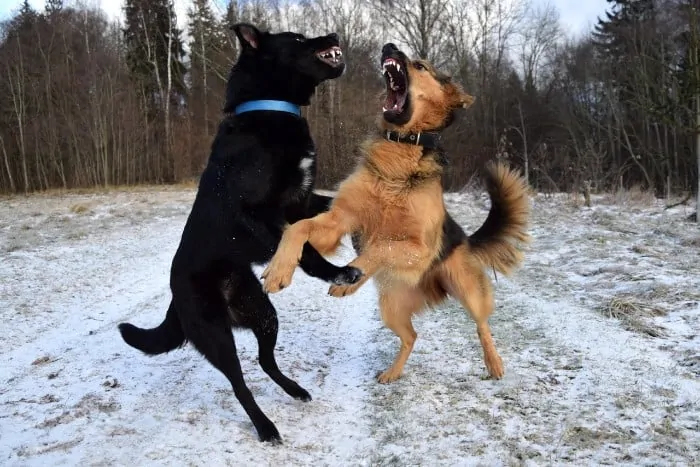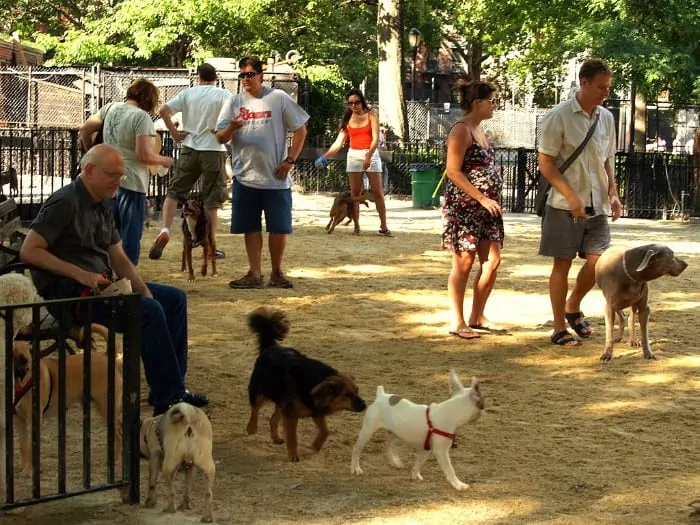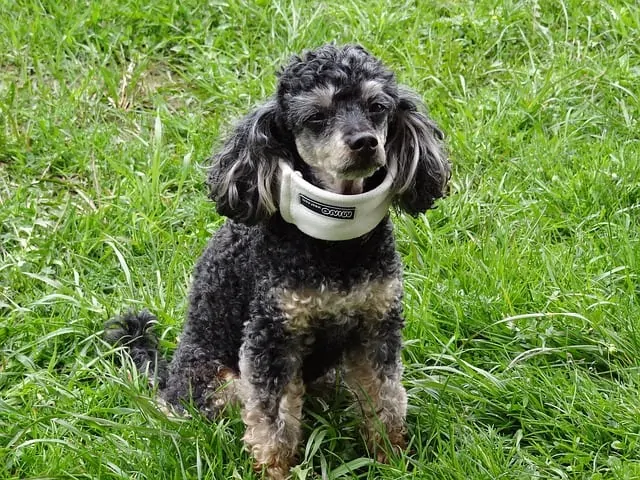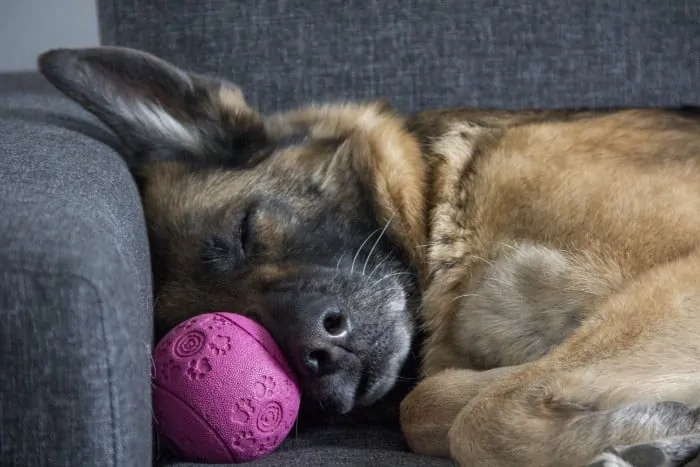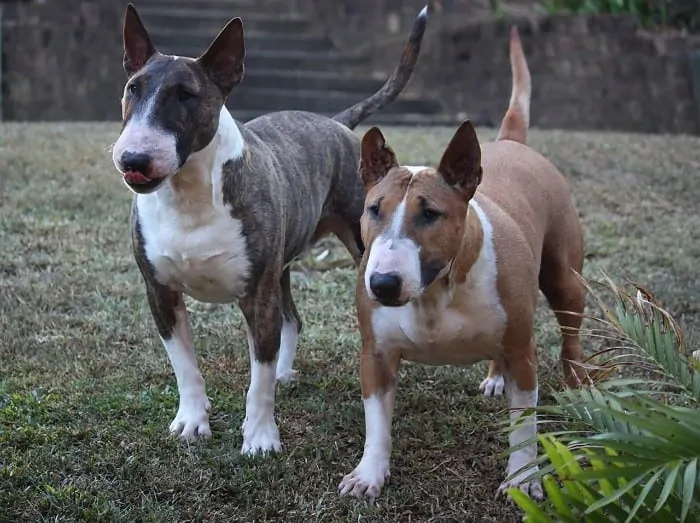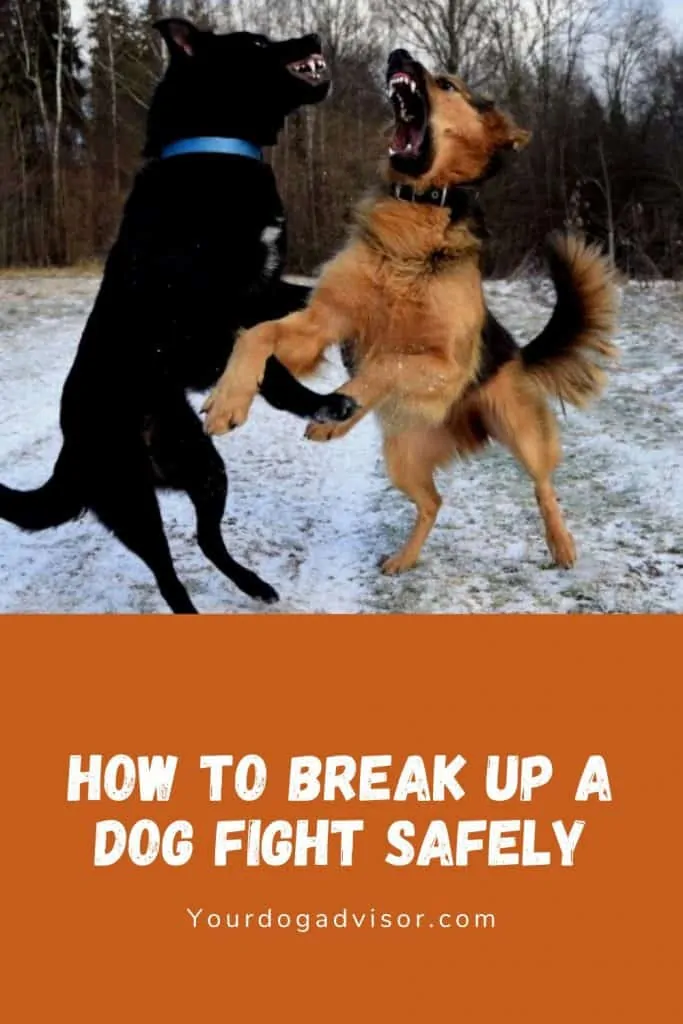It’s one of a dog parent’s worst nightmares. You are with your dog at the local dog park or visiting a neighbors yard, and a fight breaks out between your pooch and another dog. Perhaps the two were playing at first, and one or both of them became overstimulated and began playing too rough. Or maybe there was dispute over a toy or a treat. In any event, suddenly the two dogs are aggressively wrestling each other with teeth bared.
Seeing two large dogs fighting can be a very frightening experience. But don’t intervene unless you can keep yourself safe.
Seeing a dog fight can be terrifying, especially if one of the animals is your own. And stopping the fight as quickly as possible is of paramount importance because serious injuries can and do occur. With that said, it is absolutely essential that you do not physically intervene, no matter how badly you want to step in and pull the dogs apart. Dogs who are fighting are hyper-focused and instinct-driven, and even the best trained pet will bite you if you are in the wrong place at the wrong time.
Contents
Ways to Stop a Dog Fight
There are several techniques that are usually successful in breaking up a dog fight. But before you try any of them, it’s generally OK to take a deep breath and count to 10. Many dog “fights” are shows of dominance, and one or the other of the dogs will often back off within a few seconds of the fight breaking out.
If the fight goes on longer, or if the dogs appear to be injuring each other, then, of course, it’s time to intervene. Here are a few things you can try.
Distract the Dogs
Dogs who are fighting are focused on the other dog (or dogs), so simply yelling “Stop!” or “No” at the top of your voice is unlikely to have an effect. What’s more, if the dogs pick up on your anxiety, yelling may actually cause the fight to escalate. For that reason, it’s better to create a distraction with some other kind of noise. Clap your hands together loudly, or grab two heavy objects and bang them together vigorously. If there’s a metal garbage can around, bang on the side of that. Slam a door, or honk a car horn. (Most animal shelters keep air horns handy for just this purpose.) The goal is to get the dogs to react to the sound and split up. Then you can leash your dog and lead him away.
If sound isn’t working, you can squirt the dogs in the face with water if there’s a hose nearby. Or pick up a water bowl and throw the water on them — again, in their faces if you can. You can also try throwing a towel or a blanket or even a jacket over the dogs’ heads. Not being able to see each other sometimes causes the dogs to relax and stop fighting long enough for you to separate them.
Off-leash dog parks are wonderful places for dogs to socialize and have fun. But owners must remain vigilant and prepared to intervene safely if playtime turns into a fight. Source: Tompkins Square Big Dog Run by David Shankbone / CC BY-SA 3.0
If you visit a dog park where fights occur regularly, or your own dogs tend to fight, you may also want to invest in a canister of citronella spray. Unlike pepper spray or Mace, citronella is harmless to animals, but the strong smell is usually distracting enough to put an end to a fight.
Do the Wheelbarrow Maneuver
This one requires two people, but it is a very effective way to quickly end a fight especially if the dogs are large. Each person approaches one of the dogs from the rear, grabs its hind legs, and lifts it’s back end off the ground, forcing the dog to balance on its front legs. This position makes it virtually impossible for the dogs to continue to fight. Keeping the dogs’ rear end lifted, the two people then back away from each other until the dogs are far enough apart to set them down.
Put a Barrier Between the Dogs
If you’re alone and a fight breaks out between your dog and another dog, it may help to place a barrier between the two. Grab anything that’s handy — a chair, a throw rug, a blanket, a broom, a garbage can lid, even a piece of wood — and try to put it between the dogs. Again, this should only be done if you can do it safely; don’t put any part of your body in between the dogs or you may be badly hurt. Most dog fights end quickly — it’s better to wait it out than to lose a finger — or worse.
After the fight is over, separate the dogs and check them for wounds. If either of the dogs is obviously injured, use a clean cloth to apply pressure to any areas of bleeding, and wrap the dog in a light blanket to keep it warm. (This is one good reason to keep a first aid kit in your car!) If the dog is badly injured, it may quickly go into shock, a life-threatening reaction to trauma and blood loss, so take him to a vet immediately.
Dogs can sustain injuries in a dog fight that aren’t visible right away, such as soft tissue injuries, abdominal trauma and injuries to the chest.
Even if your dog appears unharmed, take him to the vet for an exam. Even a minor puncture wound from a dog bite can easily become infected, and soft tissue injuries may be present even if the skin is intact. Dogs can also sustain abdominal trauma that leads to internal bleeding or chest injuries that make breathing difficult. So be safe, and have your dog checked out.
Preventing Dog Fights
Of course, the best way to handle a dog fight is to prevent it from happening in the first place. Most fights can be avoided if pet parents are vigilant in watching their dogs interact. A dog park isn’t the place to watch YouTube videos or have an intense texting session with your BFF. Dogs can’t speak. But if we watch them closely they will tell us a great deal about what’s going on in their heads.
Fighting Versus Playing
Most, but not all, dog fights happen for a reason. Very often, dogs will start out playing, and then one or both of them becomes too stimulated and tries to dominate the other dog. In this case, the more submissive pooch will usually back off. But if that doesn’t happen, a fight can break out.
Playing dogs can sometimes look like they’re fighting, but there are important differences between the two. According to the AKC, dogs who are playing typically:
- Greet each other with the familiar “puppy bow” (chest down, rear in the air)
- Trade places as they roll around on the ground
- Assume vulnerable positions, often exposing their bellies to the other dog and allowing themselves to be “caught” after running away
- Have a relaxed jaw and an open-mouthed grin
- Growl and bark loudly and excitedly
- Keep coming back for more
Playing dogs may look like they’re fighting, but their bodies will be more relaxed and they will assume vulnerable postures, like this dog lying on its side.
Dogs who are squaring off to fight, on the other hand:
- Assume a rigid, stiff-legged stance, with the head down and jutting forward a bit, ears straight up or pinned back
- Stare at the other dog
- Exhibit “raised hackles” (the hair on the back of the neck and upper back stands up straight)
- Hold the jaw closed and bare their teeth
- Lunge at each other with short, quick movements
If you see your dog interacting with another dog, especially one with whom you’re not familiar, watch their body language for clues about what’s going on. If either dog is showing signs of aggression or wanting to fight, leash your dog and remove him from the situation immediately.
Risky Situations
In addition to knowing what behaviors to watch for, pet parents should be aware of the kinds of situations that most often devolve into a fight. Resource guarding is one of the most common triggers, especially in a dog park, where several dogs may go after the same toy. Dogs who engage in this behavior don’t want to share, and are often quite aggressive in letting other dogs know that’s the case. If you encounter a dog who’s aggressive about guarding his toys or treats, keep your dog a safe distance away.
Dogs can be very possessive of their toys, like this adult German shepherd making sure no one steals his ball while he naps.
Additionally, dogs of the same sex –especially those who aren’t neutered — are sometimes more prone to get into fights. Dogs can also adopt a “gang” mentality when a third dog enters a seemingly friendly interaction between two dogs. This typically results in the more timid dog tucking its tail and running away. But it’s possible the more dominant dogs will decide to attack.
Watching all of your dogs interactions with other dogs can help you spot these situations and intervene before a fight can start.
Remember, too, that not every dog is a good candidate for the dog park or doggie day care. Although socializing is important for dogs, it’s a sad truth that some dogs never develop good social skills. An older rescue dog, for example, may never have been given the opportunity to socialize as a pup and simply not know how to behave. Putting such a dog in a situation it can’t handle can lead to all sorts of problems, including fights.
Similarly, some dog breeds just aren’t very social with other dogs. Many terrier breeds, for example, are known for being more dog aggressive than other breeds. Of course, iit goes without saying that all dogs are individuals, and terriers are sometimes the most docile dogs on the block. But if you encounter a terrier in a dog park, keep a careful eye on its interaction with your dog until you get a sense of how they will get along.
Bull terriers can be wonderful companion dogs, but they are not always friendly with other dogs, especially those of the same sex.
The Bottom Line
Dog fights are scary and can result in injuries. As dog owners, we all have a responsibility to try to prevent dog-on-dog-aggression if we can. The best cure for a dog fight is prevention, so don’t leave your dog’s safety to chance. Whether you’re visiting a dog park or stopping by to see a friend who has a dog, watch their behavior carefully and step in if things seem to be getting out of hand. And don’t set up a fight by feeding dogs together or giving them treats at the same time. A little foresight can go a long way in keeping both you and your pets safe.

Jen Jones is a professional dog trainer and behavior specialist with more than 25 years of experience. As the founder of ‘Your Dog Advisor’ and the ‘Canine Connection’ rehabilitation center, she applies a holistic, empathetic approach, aiming to address root causes rather than merely treating symptoms.
Well known for her intuitive and compassionate approach, Jen adopts scientifically-proven, reward-based methods, encouraging positive reinforcement over punishment. Jen specializes in obedience training, behavior modification, and puppy socialization. Her innovative methods, particularly in addressing anxiety and aggression issues, have been widely recognized. Jen has worked with many of the world’s leading dog behaviorists and in her free time volunteers with local animal shelters and rescue groups.
